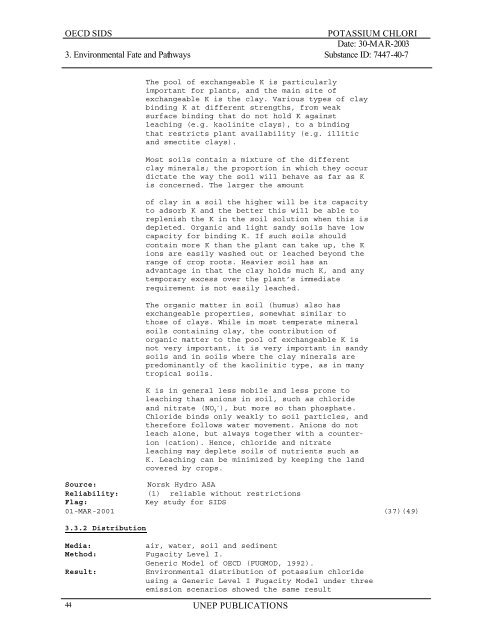POTASSIUM CHLORIDE CAS N°: 7447-40-7
POTASSIUM CHLORIDE CAS N°: 7447-40-7
POTASSIUM CHLORIDE CAS N°: 7447-40-7
You also want an ePaper? Increase the reach of your titles
YUMPU automatically turns print PDFs into web optimized ePapers that Google loves.
OECD SIDS <strong>POTASSIUM</strong> CHLORI<br />
Date: 30-MAR-2003<br />
3. Environmental Fate and Pathways Substance ID: <strong>7447</strong>-<strong>40</strong>-7<br />
The pool of exchangeable K is particularly<br />
important for plants, and the main site of<br />
exchangeable K is the clay. Various types of clay<br />
binding K at different strengths, from weak<br />
surface binding that do not hold K against<br />
leaching (e.g. kaolinite clays), to a binding<br />
that restricts plant availability (e.g. illitic<br />
and smectite clays).<br />
Most soils contain a mixture of the different<br />
clay minerals; the proportion in which they occur<br />
dictate the way the soil will behave as far as K<br />
is concerned. The larger the amount<br />
of clay in a soil the higher will be its capacity<br />
to adsorb K and the better this will be able to<br />
replenish the K in the soil solution when this is<br />
depleted. Organic and light sandy soils have low<br />
capacity for binding K. If such soils should<br />
contain more K than the plant can take up, the K<br />
ions are easily washed out or leached beyond the<br />
range of crop roots. Heavier soil has an<br />
advantage in that the clay holds much K, and any<br />
temporary excess over the plant’s immediate<br />
requirement is not easily leached.<br />
The organic matter in soil (humus) also has<br />
exchangeable properties, somewhat similar to<br />
those of clays. While in most temperate mineral<br />
soils containing clay, the contribution of<br />
organic matter to the pool of exchangeable K is<br />
not very important, it is very important in sandy<br />
soils and in soils where the clay minerals are<br />
predominantly of the kaolinitic type, as in many<br />
tropical soils.<br />
K is in general less mobile and less prone to<br />
leaching than anions in soil, such as chloride<br />
and nitrate (NO 3 - ), but more so than phosphate.<br />
Chloride binds only weakly to soil particles, and<br />
therefore follows water movement. Anions do not<br />
leach alone, but always together with a counterion<br />
(cation). Hence, chloride and nitrate<br />
leaching may deplete soils of nutrients such as<br />
K. Leaching can be minimized by keeping the land<br />
covered by crops.<br />
Source:<br />
Norsk Hydro ASA<br />
Reliability: (1) reliable without restrictions<br />
Flag:<br />
Key study for SIDS<br />
01-MAR-2001 (37)(49)<br />
3.3.2 Distribution<br />
Media:<br />
air, water, soil and sediment<br />
Method: Fugacity Level I.<br />
Generic Model of OECD (FUGMOD, 1992).<br />
Result:<br />
Environmental distribution of potassium chloride<br />
using a Generic Level I Fugacity Model under three<br />
emission scenarios showed the same result<br />
44<br />
UNEP PUBLICATIONS
















